Ray Harryhausen: The Monster Maestro
The year is 1933. A young boy and his parents go to Grauman’s Chinese Theatre. They take their seats as the lights dim and the music begins. Over the next hour and a half the young Ray Harryhausen becomes enamored with the magic of King Kong and its animation. Already a lover of dinosaurs and fantasy, Ray knew from then on that his place was in film. This trip to the cinema would forever shape the future of entertainment.
“They took you by the hand from the mundane world of the depression and brought you into the most outrageous fantasy that’s ever been put on the screen.”
– Ray Harryhausen on King Kong
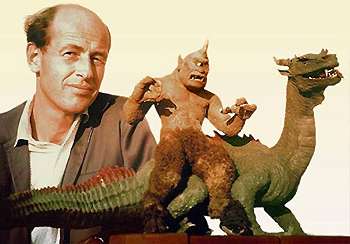
Harryhausen began animating on his own after seeing the film. Short stop-motion pictures that heavily featured dinosaurs. The boy had an incredible support system from the very beginning. His father, a former engineer, assisted in making the armatures (skeletons that are placed inside the models allowing for realistic movement and proportions) while his mother would make the costumes. After a few years of independently honing his talents, Harryhausen had the opportunity to meet the man who inspired him years prior. The man who would later kick-start his career and become his mentor. Willis O’Brien; The man behind the gorilla called Kong. O’Brien lauded Harryhausen for his talent after seeing the short samples of his work, but advised him to take the path of art school to improve the more technical aspects of his work.
Let’s make one thing clear. Ray Harryhausen is a brilliant artist. The concept art to sell the picture was made by him. The storyboards used for the shoot? Ray. The artist to make the stop-motion models? Ray again. The stop-motion animator? Yup, that’d be him as well. Ray single-handedly affected so much of the production that it would be impossible to make these movies without him. Ray was an auteur in every sense of the word.
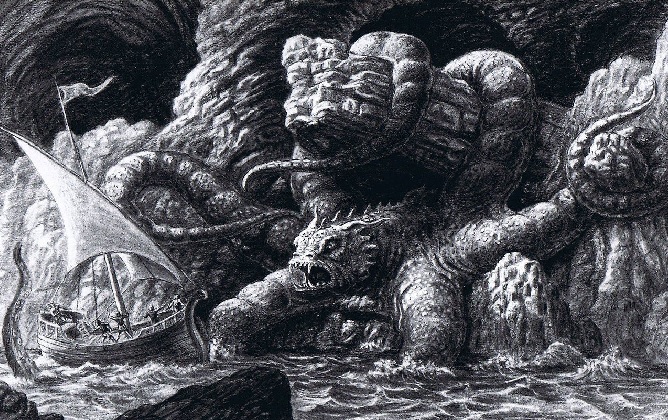
Harryhausen studied art and anatomy at the Los Angeles City College. Courses that would give him insight into the mechanics of movement. No doubt here is where Ray gained the knowledge of articulation that would set his work apart from his peers. After working on various short films -which yielded little results- Harryhausen was contacted by the very man who had ignited his passion for animation nearly two decades prior. Willis O’Brien wanted to work with Ray on a picture, very similar to his childhood film idol. A Kong-esque gorilla in the film Mighty Joe Young would be the first creature Harryhausen would animate in a feature-length capacity in a movie that would win the Academy Award for Visual Effects. Ray would take full advantage of this opportunity, heading the visual effects team for the first time in 1953 on the film The Beast from 20,000 Fathoms, about a dinosaur like creature that ascends from the briny depths to wreak havoc on New York City. Y’know, standard 50s monster movie. At this time, studios weren’t willing to invest the immense time and money that animation required, and so it became more suited to B-picture schlock and monster flicks. But Ray wasn’t interested in settling for any kind of animation that had been done before.
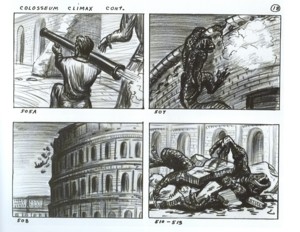
Over the course of the 1950s, Harryhausen would cement himself as a premier monster movie artist. Films like It Came from Beneath the Sea(1955), Earth vs. the Flying Saucers(1956) and 20 Million Miles to Earth(1957) featured drastically different foes each with their own innate personality. Far from human, the animator had the predicament of giving his creations a certain essence. A certain life. How do you foster sympathy for destructive beasts? The movement of his characters would set him apart from all animation that preceded his work; its effect would set him apart from every other filmmaker working at the time. When Ray was a part of a movie, he wasn’t just working on it. Harryhausen was never just a cog in the machine. He was the machine. His participation dictated nearly every facet of the movie, and he was partook in each step. Ray (with his art background, of course) would create the concept artwork for his projects. He needed to show the team exactly what fantasy he has envisioned. He would also storyboard the projects himself. In order to know exactly how he would need to animate the scene, he would have to decide exactly where the camera would be placed.

“Ray is truly unique in the history of movies as a special effects technician who is really the auteur of his films. The stop-motion creatures and vehicles Ray created were not only the stars of those movies, but the main reason for them to exist at all. Ray would conceive the stories and create illustrations and storyboards to guide the picture’s art directors and crew. He created reality – audiences cared about what was being put before them.”
– John Landis (Blues Brothers / An American Werewolf in London)
Many creative colleagues may have resented how much sway the animator had over a project, but it was, after all, his project. People saw Harryhausen movies not for the story or the acting, but the feeling of watching fantastic things brought to life. They went for him. The undeniable style and signature that was imprinted on his pictures. Make no mistake, Ray wasn’t just a good animator with a creative vision. He was the best animator with an unyielding imagination. For example, in Ray’s time there was no playback to refer to earlier frames of animation. He was essentially working blind. He would have to remember each prior movement. Every stop-motion adjustment. And in a process where each adjustment accounts for 1/24th of a second, this would be hours of meticulous work. In the more complex scenes any lapse in concentration could cause trouble.
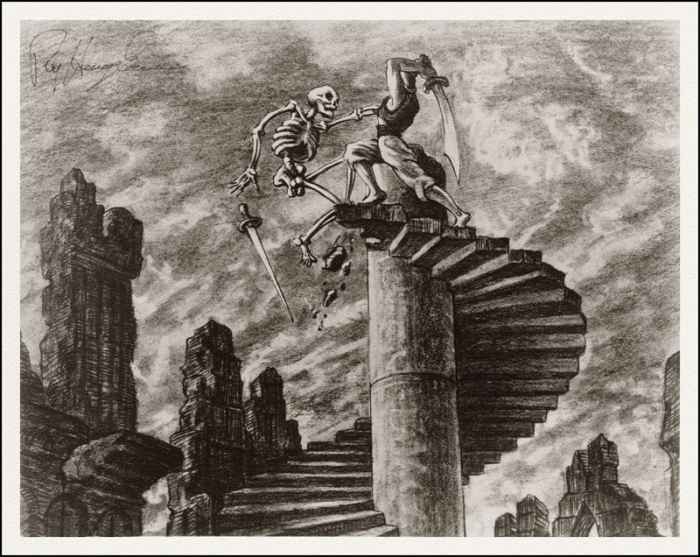
In 1958 Ray had the opportunity to depart from the Monster vs City pictures that he had been working on, to let his imagination run wild in ancient mythology. As the budget grew Harryhausen was afforded the ability to expand on his library of wonders. The 7th Voyage of Sinbad and its cast of creatures anchored the film. Dragons, skeletons and cyclopes populated the Arabian desert with fantasy. These pictures also gave him the liberty to lean further into the craft, constantly taking on more difficult animations -sometimes just to try something new. Although the infamous sailor never fought a skeleton in any of his stories, Ray put one in the film because he always wanted to animate a skeleton. He wasn’t concerned with the source material as he was resolute in bringing the most intriguing sights to screen. The film was a box office success and widely praised. Ray was on a new path. Five years later, Ray would get a shot at another classic of mythology. Migrating from Baghdad to Greece in 1963’s Jason and the Argonauts, he upped the intricacy of his work. The Greek hero who sought the Golden Fleece was the perfect setting to mix in fabled wonders. Instead of one creature on scene at a time he would have multiple; each moving independently. Jason’s battle with the seven-headed hydra was his attempt at a creature with many limbs. And it turned out to be quite the new test. Each head has to act act individually but also fluid and
“[The Hydra] presented so many animation problems I didn’t anticipate. For one if the telephone rang and I was in the midst of animation, I would forget -sometimes- whether this head was going forward of backward and that head going up or down. And the various other problems with the other heads; it became quite confusing.”
– Ray Harryhausen The Harryhausen Chronicles
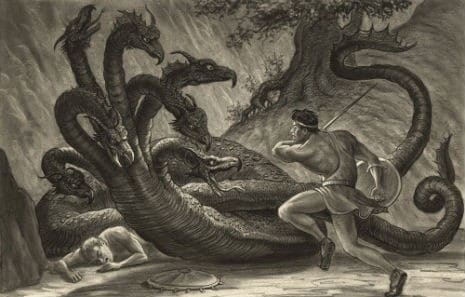
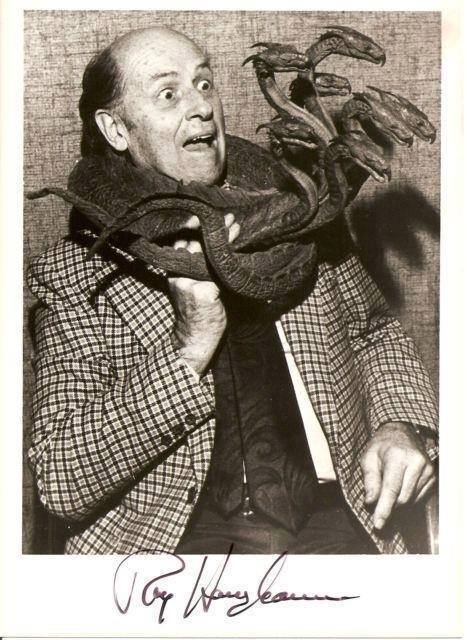
As impressive as the Hydra was for the time, it’s Jason’s climactic fight that remains Harryhausen’s most iconic work. As Jason has just gotten a hold of the Fleece, King Aeëtes raises seven skeletons from the dead. The fight was so intensive that it took four and a half months to complete the stop-motion. The live shoot itself, however, only took a few weeks to shoot. The actors would practice the fight choreography with stuntmen until they had mastered the motions. Then when the cameras rolled, the stuntmen backed out and the actors would shadow-box the fight. Ray would then animate the skeletons into the scene. Seven individual skeletons. A monstrous task for Ray. Seven skeletons each with five moving appendages (arms,legs, head) means thirty five separate adjustments for every new frame shot. That’s around 50,000 adjustments for every minute they are all on screen together.
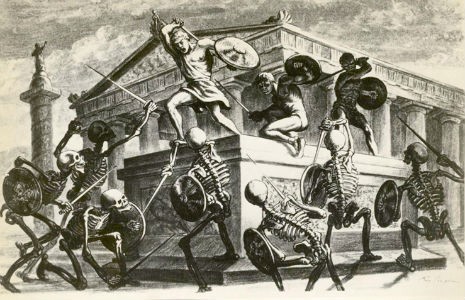
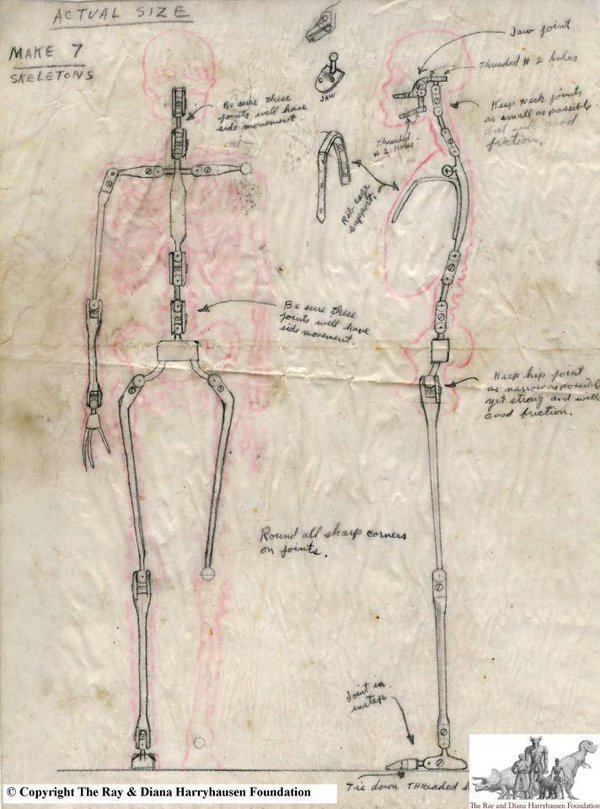
Ray wasn’t just exhaustive in his technical skills. He practiced this craft like an art and loved the art behind it. All the subtle movements and idiosyncrasies that made something feel alive. The Golden Voyage of Sinbad contains a scene that is my personal favorite of Ray’s work, and a perfect example of his mastery of the art. In the pursuit of an evil prince, Sinbad comes face to face with a living statue of the Goddess, Kali. A goddess borrowed from the Hindu religion, of course, but Ray didn’t care. He had always been fascinated with the six-armed character and wanted to bring her to life (literally and figuratively) on screen, actually having reference movements done by using 3 stuntmen strapped together. Kali posed a similar problem as the Hydra; multiple limbs on one model and each limb moving individually. The difference with Kali is in her human-like form. Her hands change shape as she moves and her arms all act in perfect synchronization with the rest. The concentration to keep track of all those variables without any reference to all previous frames sounds impossible. The scene is mesmerizing. The fluidity of his animation -keeping in mind that it’s all manual- is amazing. He transitions from Kali performing a dance to sword-fighting and never misses a beat.
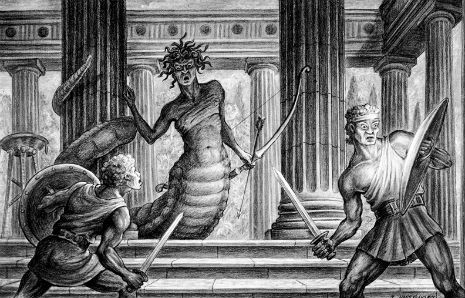
His final film work, Clash of the Titans, was released in 1981. An adaptation of the Greek myth of Perseus and his heroic origins. Ray would bring to life the likes of the majestic Pegasus and mighty Kraken, but the lasting images of this film will forever be the serpent Gorgon Medusa. Historically portrayed as a pretty girl with a head full of snakes. Ray knew he’d have to do something about that. Never a stickler for the source material, he decided to lean heavily into the serpent visage. He presented a more scaly interpretation complete with the tail of a rattlesnake. She was more demonic than ever. In addition to animating Medusa’s body, Ray also had the task of animating the twelve writhing snakes that comprise her hair. The scene is also a stark departure from the usually day-lit outdoor scenes, taking place in the dim glow of the Gorgon’s lair. From the moment she crawled out of the shadows and into the frame, the audience knew that Ray Harryhausen had changed animation standards yet again.
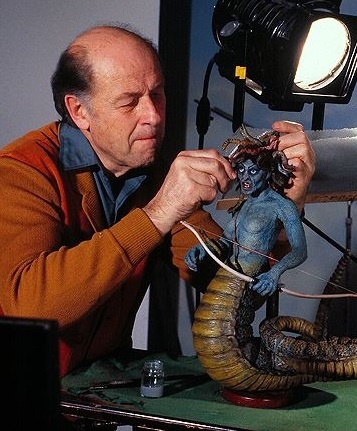
Unfortunately for all of us, this was Ray Harryhausen’s last endeavor into animation. After over 30 years in the industry, at the age of 61, he walked away from the craft that made him a household name. Ray said that there were a number of reasons why he decided to call it quits. Perhaps he didn’t believe his previous work was living up to his own high expectations. Perhaps with the passing of the 70s Ray saw the writing on the wall for traditional animation. This was, after all, a year after the release of The Empire Strikes Back and with the rise of new effects entities like Industrial Light & Magic, it seemed like Ray was doomed to be overtaken by the next generation of effects junkies that he had inspired in the first place. Because make no mistake about it; Without Ray Harryhausen, movies as we know them today wouldn’t exist. Ray’s effect on the film industry was great and far-reaching. George Lucas, John Landis, James Cameron, Tim Burton, Edgar Wright, Peter Jackson and countless others credit Ray as having a large influence on them. Some of the greatest technical and creative pioneers in film whom all cite Ray and his films as inspiration. A formative presence in their lives. Without Ray, perhaps many of them never fall in love with effects and animation. Compaines like ILM, Digital Domain, and Weta Digital might have never been founded. His influence on practical and CGI effects as we know them today can’t be overstated. Ray was the technician who inspired artists.
“Without Ray Harryhausen, there would likely have been no ‘Star Wars’”
– George Lucas (Star Wars)
On the 7th of May, 2013 at the age of 92, Ray Harryhausen died. One of cinema’s most important figures; he left behind a legacy of wonder that lives on today and will continue to live on in those that he influenced and then in generations influenced by them. No matter how complex the the effects, none would be possible without the maestro and his monsters.
“It seemed as if the world of cinema had moved on from fantasy, but not for me. In 1996, while I was building up a computer visual effects facility in Wellington, New Zealand, I still wanted more than anything to make a movie just like the films that inspired me throughout my life. I wanted to make my ‘Jason’, or my ‘Sinbad’… The Lord of the Rings is my ‘Ray Harryhausen movie’. Without that life-long love of his wondrous images and storytelling, it would never have been made – not by me at least.”
– Peter Jackson (Lord of the Rings)
The preservation of Ray’s work is upheld by The Ray and Diana Harryhausen Foundation. The foundation houses his collection and furthers his support for the art of stop-motion animation. If you wish to support the foundation in preservation of Ray’s legacy and continued impact you can do so via their site.
What do you think? Leave a comment.
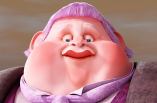

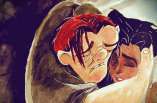








Harryhausens creations continue to feed the imagination far more than any CGI that I’ve yet to see.
I saw ‘Jason and the Argonauts’ and ‘Clash of the Titans’ when I was a kid, when special effects had already moved on leaps and bounds, but I remember Medusa, Talos, Pegasus and the skeletons far more vividly than anything else, because it actually felt real.
Absolute legend.
I don’t think it’s the fact it’s stop-motion animation that makes the films so good, but his work in it. As a kid watching them as re-runs on TV, a child of the Jurassic Park era, they still markedly impressed and grabbed me for their personality.
Such a good piece. It’s all about the battle with the skellingtons for me! I drew that on a thousand pads when I was a kid, and replayed it in my head, and on the playground with my friends, not one of whom was born when the film came out by a long way. Who will remember a single CGI battle in a few weeks? Sure, some of the Harryhausen effects could be ropey, but at the best they were full of aesthetic, artistic and narrative vision.
If Harryhausen is the father in this field, what does that make Willis O’Brien, Vladislav Starevich or George Melies? Harryhausen is a living legend, but there were others before him.
My dad was a big fan of George Melies. I thought the suits were a bit over the top though.
Wasn’t his surname spelt differently?
Melly – Melies. Nice pun! I particularly loved the black and white checkerboard suit.
Grandfathers?
Borges would called them “precursors.”
I can still remember being scared shitless of Medusa when I was a kid. Great memory.
One of the all-time greats. There’s more heart & craft in one scene of his than whole movies’ worth of soulless CGI (yeah, bring on the old CGI-vs-Stopmotion Animation bunfight!). I met him at a booksigning years ago, an incredibly proud moment for me.
A good article. I remember Harryhausen movies, The 7th Voyage of Sinbad was always a favorite.
Utter legend.
The Medusa sequence in Clash of the Titans is still one of the most scary in movie history for me. And the beauty of Pegasus still one of the most poetic, for me. I love this movie. No CGI will ever produce this sort of dreamlike charm.
I agree. I was transfixed on the Medusa sequence but the balance between magical moments and terrifying foes was brilliantly constructed by such brilliant effects. The films are still worthy of viewing and I stay fro the ride whenever a Harryhausen film is on the telly.
The man.
genius who’s films along with star wars and jimmy bond actually kept this little boy sane without them my child hood would have been totally and utterly soulless and dark.
I think the escapism they offer is oddly comforting even when the monsters are scaring the bejaysus out of you! Hope things are happier for you now.
Lovely tribute. I saw Jason and the Argonauts as a child at my dad’s company’s sports club one evening. They had a TV room with a big colour TV and big green armchairs. I was probably about four or five and it scared the crap out of me – but I couldn’t stop watching. My brother was able to make me cry for years afterwards by whispering about the Children of the Hydra’s Teeth late at night (or in tube trains – he used to insist that skeletons would come out of the tunnel walls when the train stopped). Gosh, I was a wimp.
I have a copy of Argonauts now. I’m very fond of it, especially Hercules, who these days would be some oiled, buff, waxed-chested man in his mid 20s (no flabbyness and saggy loincloths for the twentyfirst century, no sir!); but yes, Talos is terrifying, as are the harpies (seagulls sound just like them when they wake you at 3 am) and the Children of the Hydra’s Teeth. It’s also funny to watch just to see the old British actors in it (including a former Dr Who).
Harryhausen really was the Master of the craft – fittingly the swanky restaurant in Monsters Inc was named after him!
I was pleased and amazed to recently discover the dramatic sculpture of Livingtone being attacked by a lion, at The David Livingstone centre in Blantyre, was designed by Harryhausen. Practicaly on my doorstep.
Still prefer his stuff to the slicker but soulless CGI everywhere today.
I can only echo that comment, Harryhausen’s creatures always felt more alive to me.
One key to Harryhausen’s genius is that he invests his creatures with much more personality than almost any other special effects professional. The other key aspect is the sheer imagination and creativity he puts into their design. It’s not about any inherent virtues that stop-motion has as a technique- it’s about the passion and creativity he put into bringing his monsters to life, and the fact that he was given a degree of auteur status, and trusted to conjur up the kind of monsters and wonders that producers knew would make or break a movie. These days, all too often the special effects guys are treated as mere technicians, hired to do a job, and to stick to the script.
Excellent article! Many thanks for this informative exploration of this great pioneer.
Great article! never knew about this guy except through “Monster’s Inc.” There’s a joke 100 years in the making!
I was too young for the first wave of his movies, but saw them numerous times on afternoon or late-night TV. It was always a magical experience to see those movies growing up. Clash of the Titans was one that I was able to see in the theatre, and that too was a great film to watch as a child.
His work still blows my mind, a real magic.
A true genius who has given the cinema some of the most wonderous and beguiling imagery ever committed to celluloid.
His animation puts CGI to shame and will live forever in the hearts and minds of all those who have had the pleasure to see them.
Any film involving him is worth watching. One of cinema’s all time greats!
Ray Harryhausen the Godfather of creature effects.
Give me one of his beautifully crafted creations over a 1000 CGI rendered wannabes
Talos scared the shit out of me as a kid. So much character and life in his work
Harryhausen is boss. Phyiscal effects always beat CGI attempts to depict physical objects.
Caught a bit of one of the Star Wars movies on TV the other day — I thought ‘Harryhausen could do it better’
i still remember seeing his movies as a child. They were fabulous, and possessed a compelling sense of time and place beyond the effects. There is quality of wonderment that is sorely lacking in movies that have similar aspirations today.
Legend, Pioneer and oft the cause of my rushing behind the sofa on a Saturday afternoon.
Ah the memories, those Sinbad movies rock.
Harryhausen had his own unique flavour. That was made his work so interesting. It felt alive and direct.
A fantastic read and I really enjoyed helping in the editorial process. Your love for your subject matter and your sense of humour comes across really well.
Way back in time, when I was an art student, I once turned my hand to stop frame animation, so I can attest to just how time consuming and difficult it is. Harryhausen was truly a master of the art.
After helping in the editorial stage, I tracked down ‘Jason and the Argonauts.’ I hadn’t watched it in many, many years, but I was suprised at just how well it still holds together. It brought back some fun memories of my brothers and I watching these classic films together, whilst tucking into Jaffa cakes.
He made me, he makes me, and he will make me to experience a sense of wonder and awe.
It’s nice to know that a lot of people had talent even there is no high technology like what we have today.